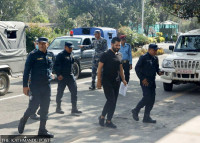National
Poor quarantine facilities could themselves become outbreak hotspots, doctors warn
In quarantine, people are closely packed into small spaces and they continue to share things like cigarettes, raising the risk of the virus spreading among them..jpg&w=900&height=601)
Arjun Poudel
Of the three people who tested positive for Covid-19 on Saturday, two—a 21-year-old man from Kailali who had returned from Mumbai and a 41-year-old man from Kanchanpur who returned from Uttarakhand, India—had spent 11 days in quarantine when they came down with symptoms.
There were, however, 44 people in the quarantine facility in Kailali and 13 in Kanchanpur, with these patients.
“Such quarantine facilities where we are keeping people in the dozens are risky,” said Dr Sher Bahadur Pun, a virologist at Sukraraj Tropical and Infectious Disease Hospital in Teku. “A single infected person can easily pass the virus to several others.”
Over the last few days, people in large numbers have arrived from India. Though after the lockdown thousands of them have been stopped on the other side of the border, those who made it to Nepal have been placed in quarantine facilities where they are living in close proximity with each other and sharing many things, including cigarettes and chewing tobacco. In some instances, people in quarantine are even sharing beds, according to Pun.
“Such negligence can jeopardise the lives of many others,” said Pun. “We have locked down the entire nation to contain the risks but have failed to manage proper quarantine facilities. This defeats the whole purpose of lockdown and social distancing.”
The government has not yet defined quarantine, isolation and social distancing properly, nor has it arranged for proper quarantine facilities in various districts outside the Valley.
About a week ago, after the fourth case was detected in Dhangadhi, Dr Gunaraj Awasthi, health director of Sudurpaschim Province, had complained that the federal government’s failure to properly define what constitutes quarantine and isolation had created confusion regarding what kind of facilities they were supposed to set up.
People are generally kept in quarantine when they are suspected to have been exposed to the disease but are not ailing. They are generally kept in isolation once they come down with symptoms and test positive for the diseases. But the government has used the terms isolation and quarantine interchangeably. For instance, the Health Ministry’s Covid-19 online portal says that 113 people are currently in isolation, but it is unclear what exactly that entails.
Dr Mingmar Gyelgen Sherpa, former director of the Department of Health Services, agrees that the quarantine facilities built in most districts are problematic.
“We should manage those centres properly to curb the spread of disease,” Sherpa told the Post. “Otherwise, those quarantine facilities themselves can become outbreak hotspots.”
In much the same way that the government has failed to provide proper quarantine facilities, social distancing remains contested in Nepal. The government has imposed a nationwide lockdown, shutting down schools, public transport, movie theatres, stadiums and forced people indoors, but shops selling daily essentials are allowed to open a few hours in the morning and evening, creating crowds of people at these times.
“Avoiding mass gatherings and maintaining distance constitute social distancing,” said Sherpa. “But if there are crowds at grocery stores, how can we get the desired result?”
Testing everyone who has returned from countries with active outbreaks, including India, while placing them in proper quarantine facilities is the only way to prevent the coronavirus from spreading in the community, said Sherpa.
Dr Bikash Devkota, spokesperson for the Health Ministry, said that the ministry was aware of the concerns expressed from several quarters regarding the condition of quarantine facilities.
“No doubt, such facilities should meet minimum standards,” he said at a regular press briefing on Sunday. “We will request provincial and local governments to ensure that standards are met and that these facilities are monitored.”




 8.12°C Kathmandu
8.12°C Kathmandu















